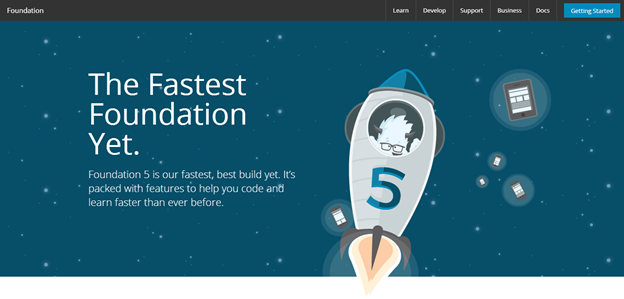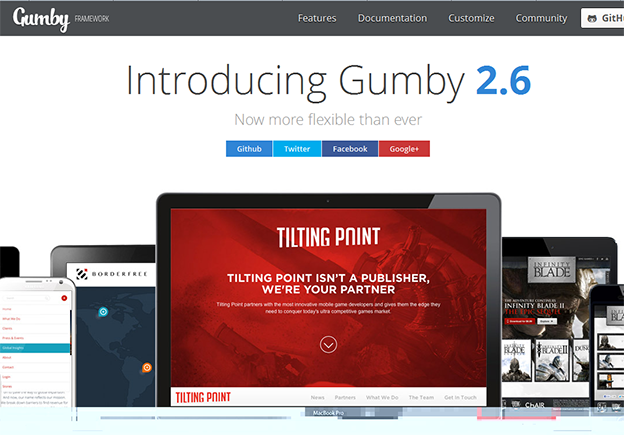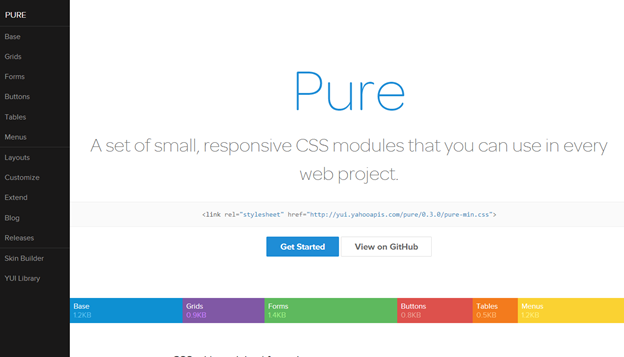Starting a new year could hardly get any better for web designers than this. We have some of the best and most powerful web designing frameworks just waiting to be explored. These are frameworks that can help you build fully functional web templates within minutes and with extremely minimal knowledge of CSS and JavaScript coding. There are great expectations for the year 2014. Responsive websites are already the Next Big Thing. Visitors from mobile and tablets have become an important factor for all websites. Every website has to look good and work well in every device. In this article, we will list some of the best CSS frameworks that will help web designers and developers to explore their potential to build responsive and beautiful web applications in 2014
Twitter Bootstrap 3
 Whether you want to design a personal portfolio, a business website or a shopping cart, Twitter Bootstrap’s flexible and responsive capabilities will come in handy in all cases. It’s more than just a mere set of CSS and JavaScript rules, Twitter Bootstrap has within it an inbuilt responsive powerhouse. With many new features added to the third version of Twitter Bootstrap, it has once again proven that it is here in the web industry for the long run.
The JavaScript components of Twitter Bootstrap help you to design sliders that can run in any kind of device. Components like Modals, Dropdown, ScrollSpy, Tab, Tooltips, Popovers and Carousels are some of the best things you will like about Twitter Bootstrap.
You can start learning Twitter Bootstrap 3 today and make your web experience far more better in the year 2014. Try Twitter Bootstrap 3.
Whether you want to design a personal portfolio, a business website or a shopping cart, Twitter Bootstrap’s flexible and responsive capabilities will come in handy in all cases. It’s more than just a mere set of CSS and JavaScript rules, Twitter Bootstrap has within it an inbuilt responsive powerhouse. With many new features added to the third version of Twitter Bootstrap, it has once again proven that it is here in the web industry for the long run.
The JavaScript components of Twitter Bootstrap help you to design sliders that can run in any kind of device. Components like Modals, Dropdown, ScrollSpy, Tab, Tooltips, Popovers and Carousels are some of the best things you will like about Twitter Bootstrap.
You can start learning Twitter Bootstrap 3 today and make your web experience far more better in the year 2014. Try Twitter Bootstrap 3.
Foundation Framework
 Foundation Framework by Zurb has emerged in the second half of 2013 as one of the best frameworks for web designing with its version 5.0. With features similar to that of Twitter Bootstrap—and some significant enhancements—it is expected to climb the ladder of popularity in 2014.
Foundation framework boasts a 12 grid system similar to Twitter Bootstrap. It also provides reusable HTML components and JavaScript plug-ins in its package. But unlike Twitter Bootstrap, Foundation has support for Sass stylesheets. You need to compile the Sass stylesheet, convert it into normal CSS files and then use them in your project. Adding Sass support makes it more customizable for designers who want to give that personal touch to the websites.
With features like Off Canvas and Improved form, it would be interesting to see web developers explore this framework to the most in 2014. Refer to Tahir Taous’s article to know what’s new in Foundation 5. Try Foundation 5.
Foundation Framework by Zurb has emerged in the second half of 2013 as one of the best frameworks for web designing with its version 5.0. With features similar to that of Twitter Bootstrap—and some significant enhancements—it is expected to climb the ladder of popularity in 2014.
Foundation framework boasts a 12 grid system similar to Twitter Bootstrap. It also provides reusable HTML components and JavaScript plug-ins in its package. But unlike Twitter Bootstrap, Foundation has support for Sass stylesheets. You need to compile the Sass stylesheet, convert it into normal CSS files and then use them in your project. Adding Sass support makes it more customizable for designers who want to give that personal touch to the websites.
With features like Off Canvas and Improved form, it would be interesting to see web developers explore this framework to the most in 2014. Refer to Tahir Taous’s article to know what’s new in Foundation 5. Try Foundation 5.
Gumby Framework
 Gumby Framework is built on a Sass preprocessor that allows you to customize and build designs on top of the Gumby Framework. Designing with Gumby will require you to understand the basics of Sass. It can be customized by changing the variables values using Sass. Modular scale is another great inbuilt feature of Gumby that uses a Golden Ratio tool for typography.
Just like Twitter Bootstrap 3, Gumby framework provides support for Internet Explorer 8 and above and all the open source modern browsers.
Continuing with the industry standards, Gumby also has the 12 grid layout system. It logically divides the browser’s space into 12 grids and supports nested gridding. Some new concepts like Hybrid Grids, Tiles, Fancy Tiles and Semantic Tiles make this framework unique and definitely worth trying. Reusable CSS and JavaScript plugins are also provided by Gumby Framework. Try Gumby Framework.
Gumby Framework is built on a Sass preprocessor that allows you to customize and build designs on top of the Gumby Framework. Designing with Gumby will require you to understand the basics of Sass. It can be customized by changing the variables values using Sass. Modular scale is another great inbuilt feature of Gumby that uses a Golden Ratio tool for typography.
Just like Twitter Bootstrap 3, Gumby framework provides support for Internet Explorer 8 and above and all the open source modern browsers.
Continuing with the industry standards, Gumby also has the 12 grid layout system. It logically divides the browser’s space into 12 grids and supports nested gridding. Some new concepts like Hybrid Grids, Tiles, Fancy Tiles and Semantic Tiles make this framework unique and definitely worth trying. Reusable CSS and JavaScript plugins are also provided by Gumby Framework. Try Gumby Framework.
Yahoo Pure CSS
 Yahoo Pure or Pure CSS is a lightweight CSS framework by Yahoo. It’s both extremely light and also responsive in nature. Unlike other frameworks, Yahoo Pure doesn’t have any JavaScript Plugins.
This framework also utilizes the popular 12-grid-layout system and has its own CSS rules to apply. For people who like the metro design of Windows, Yahoo Pure is the perfect CSS framework to start designing with. It promotes less shadow effects and almost no rounded corners in its designs. Yahoo’s skin builder can be used to customize the look when using Pure CSS.
Yahoo Pure CSS is perfect for developers who would like to stick to their respective framework but like to use the flat design. To achieve this, you have to just include the CSS file that is provided in the CDN by Yahoo. Try Pure CSS.
Yahoo Pure or Pure CSS is a lightweight CSS framework by Yahoo. It’s both extremely light and also responsive in nature. Unlike other frameworks, Yahoo Pure doesn’t have any JavaScript Plugins.
This framework also utilizes the popular 12-grid-layout system and has its own CSS rules to apply. For people who like the metro design of Windows, Yahoo Pure is the perfect CSS framework to start designing with. It promotes less shadow effects and almost no rounded corners in its designs. Yahoo’s skin builder can be used to customize the look when using Pure CSS.
Yahoo Pure CSS is perfect for developers who would like to stick to their respective framework but like to use the flat design. To achieve this, you have to just include the CSS file that is provided in the CDN by Yahoo. Try Pure CSS.
InK Interface Kit
 Being new to the industry and having learned from its seniors, InK provides solutions that most people could be looking for. It has both reusable HTML and JavaScript Plugins. The most unique feature in this framework is the ability to provide drag and drop support—which is still not present in Twitter Bootstrap 3, for example.
InK provides an amazing set of form validation classes which comes in very handy. Image processing is also another power feature. Using InK you can create multiple versiona of the same image and reduce the load time in various device types. It also has an impressive set of MIT licensed icons to play with.
With such an amazing set of power tools, InK is worth trying as a web designing framework, today. Try InK.
Other frameworks to try:
These are, at least, some of the best web designing frameworks that you can try in 2014. Why use frameworks at all? Well, who wants to start from scratch?
Note that the above list is not ranked in order of preference or excellence, it’s just list. Every framework listed has its own client, advantages and limitations.
I hope you enjoyed reading through the list. Now it’s your turn to let us know know which one of the above frameworks you think will have the greatest impact on web designers and developers in 2014. Leave your comments below, with supporting text.
We hope you have an amazing Christmas 2013, and a Happy New Year in 2014.
Being new to the industry and having learned from its seniors, InK provides solutions that most people could be looking for. It has both reusable HTML and JavaScript Plugins. The most unique feature in this framework is the ability to provide drag and drop support—which is still not present in Twitter Bootstrap 3, for example.
InK provides an amazing set of form validation classes which comes in very handy. Image processing is also another power feature. Using InK you can create multiple versiona of the same image and reduce the load time in various device types. It also has an impressive set of MIT licensed icons to play with.
With such an amazing set of power tools, InK is worth trying as a web designing framework, today. Try InK.
Other frameworks to try:
These are, at least, some of the best web designing frameworks that you can try in 2014. Why use frameworks at all? Well, who wants to start from scratch?
Note that the above list is not ranked in order of preference or excellence, it’s just list. Every framework listed has its own client, advantages and limitations.
I hope you enjoyed reading through the list. Now it’s your turn to let us know know which one of the above frameworks you think will have the greatest impact on web designers and developers in 2014. Leave your comments below, with supporting text.
We hope you have an amazing Christmas 2013, and a Happy New Year in 2014.
Frequently Asked Questions about Web Designing Frameworks
What are the key features to look for in a web designing framework?
When choosing a web designing framework, there are several key features to consider. Firstly, the framework should be easy to use and have a user-friendly interface. It should also have a strong community support for troubleshooting and updates. The framework should be flexible and customizable to suit your specific needs. It should also be compatible with various platforms and browsers. Lastly, it should have good documentation and learning resources to help you get started.
How do I choose the best web designing framework for my project?
Choosing the best web designing framework for your project depends on your specific needs and requirements. You should consider the complexity of your project, your level of expertise, the time you have to learn a new framework, and the resources available to you. You should also consider the scalability of the framework, its performance, and its compatibility with other technologies you are using.
What are the top web designing frameworks in 2014?
In 2014, some of the top web designing frameworks included Bootstrap, Foundation, AngularJS, Ember.js, and Backbone.js. These frameworks were popular due to their robust features, flexibility, and strong community support.
What are the latest trends in web design in 2014?
In 2014, some of the latest trends in web design included responsive design, flat design, parallax scrolling, single page websites, and the use of large, high-quality images and videos. These trends were driven by the increasing use of mobile devices and the need for websites to be visually appealing and easy to navigate.
How do web designing frameworks impact the performance of a website?
Web designing frameworks can greatly impact the performance of a website. They can make it easier to create responsive designs, improve the speed of the website, and enhance its functionality. However, they can also add extra weight to the website and slow it down if not used properly.
What are the benefits of using a web designing framework?
Using a web designing framework can save you time and effort in the web development process. It provides a structured approach to web design, making it easier to create consistent and professional-looking websites. It also comes with pre-built components and features that can enhance the functionality of your website.
Are there any drawbacks to using a web designing framework?
While web designing frameworks offer many benefits, they also have some drawbacks. They can be complex to learn, especially for beginners. They may also limit your creativity and flexibility as they come with pre-defined structures and components. Additionally, they can add extra weight to your website, potentially slowing it down.
How do I learn to use a web designing framework?
There are many resources available to learn how to use a web designing framework. These include online tutorials, video courses, books, and community forums. It’s also helpful to practice by working on small projects or redesigning existing websites using the framework.
Can I use more than one web designing framework for a project?
Yes, it’s possible to use more than one web designing framework for a project. However, it’s important to ensure that the frameworks are compatible and that they don’t conflict with each other. It’s also important to consider the added complexity and potential performance issues that may arise from using multiple frameworks.
What is the future of web designing frameworks?
The future of web designing frameworks is likely to be driven by the evolving needs of web developers and the changing trends in web design. We can expect to see more advanced features, improved performance, and greater flexibility in future frameworks. There is also likely to be a greater focus on mobile-first design, given the increasing use of mobile devices for web browsing.
 Syed Fazle Rahman
Syed Fazle RahmanWeb Designer with over 6 years of experience, including user experience and front end development. Currently, CEO and Co-Founder of Hashnode, a network of software developers. Has published two books: Jump Start Bootstrap and Jump Start Foundation for SitePoint Premium.

